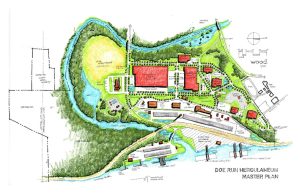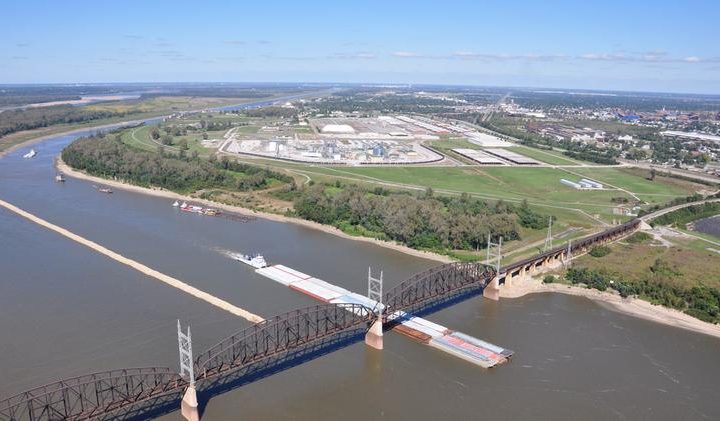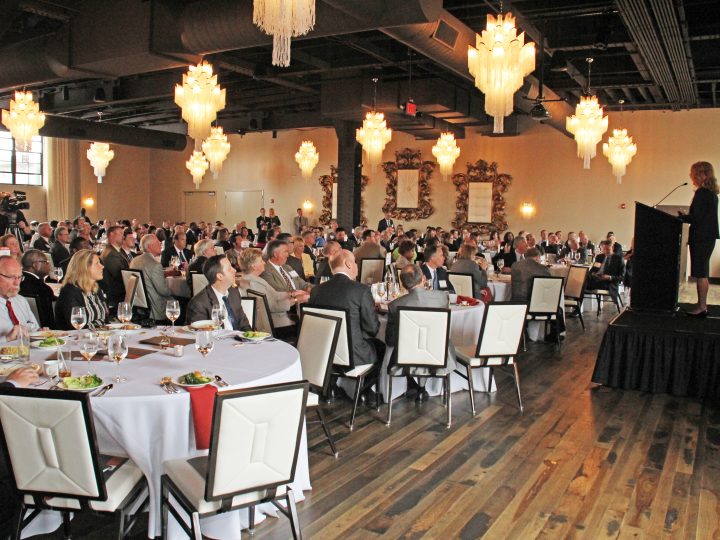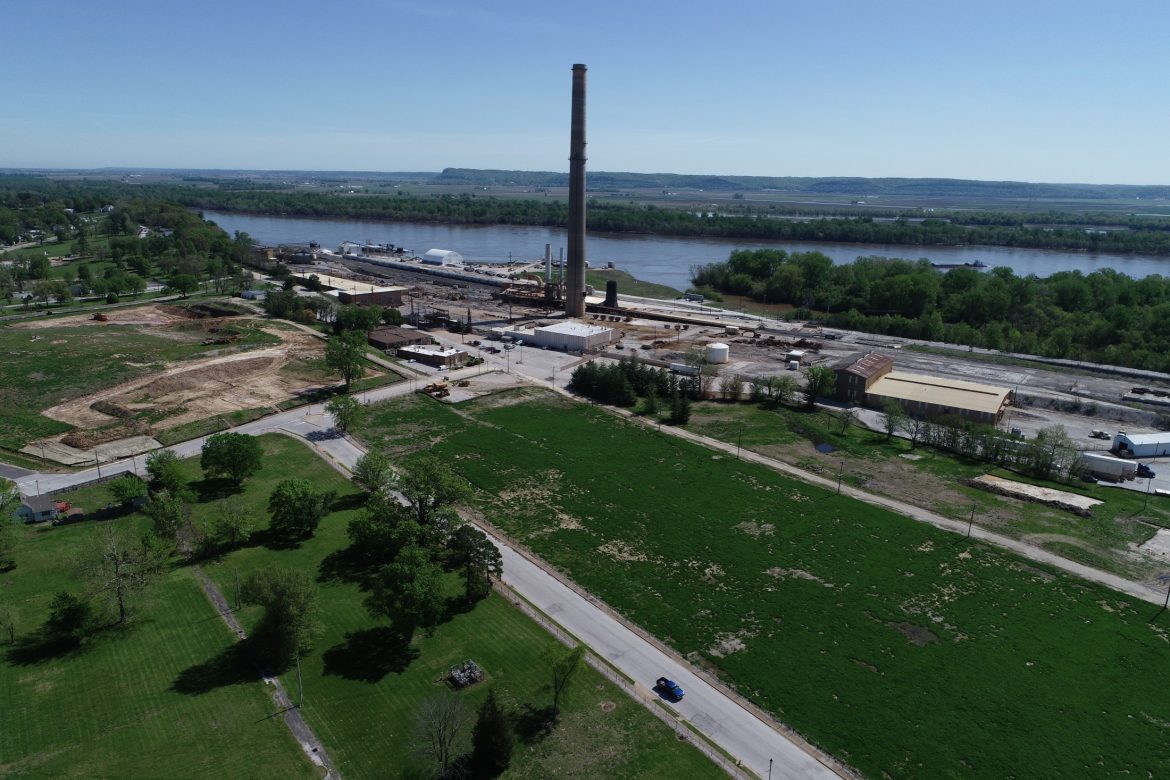
The St. Louis Regional Freightway calls a 300-acre Port District zoned property along the Mississippi River in Herculaneum, Missouri, a unique and unprecedented opportunity for intermodal development, citing the location’s more than two miles of river frontage, 200-acre buffer, 30,000 linear feet of Class I rail and access to Interstate 55. The site recently received Port District zoning making way for redevelopment as an intermodal transportation hub and industrial park.
Located on the shipping lanes of the Mississippi River, the site has been utilized since the 1700s as a port. With its easy access for barge loading and offloading and the site’s proximity to early lead mines in adjacent Washington County, under early French ownership the port was utilized to ship lead cannonballs and shot to Europe to support Napolean’s army. Today, the port ships frac sand, grain, and other bulk commodities.
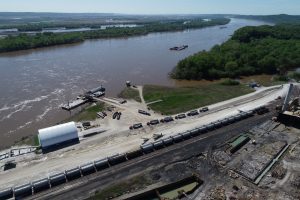 “Few inland port sites available for new development have the infrastructure and ease of access to both rail and highway of this site,” said Mary Lamie, Executive Vice President of Multimodal Enterprises for Bi-State Development, and head of the St. Louis Regional Freightway. “The site’s 30,000 linear feet of Class I rail operated by Union Pacific Railroad, along with the less than 2-mile distance to Interstate 55 make it ideal for movement of goods nationally and internationally. It is a great addition to the existing pipeline of 16 available rail-served sites in the two-state area.”
“Few inland port sites available for new development have the infrastructure and ease of access to both rail and highway of this site,” said Mary Lamie, Executive Vice President of Multimodal Enterprises for Bi-State Development, and head of the St. Louis Regional Freightway. “The site’s 30,000 linear feet of Class I rail operated by Union Pacific Railroad, along with the less than 2-mile distance to Interstate 55 make it ideal for movement of goods nationally and internationally. It is a great addition to the existing pipeline of 16 available rail-served sites in the two-state area.”
The Doe Run Company (Doe Run) owns the property and is slated to complete remediation of a former smelter site located on the property in 2024. The site includes existing industrial services for water, gas and electric. Doe Run is committed to ensuring the long-term success and growth of this site, making it a valuable partner with local and regional economic development agencies for future development opportunities.
The Jefferson County Port Authority and Jefferson County officials developed a master plan for the site, with a goal of creating additional port facilities and riverfront development that allows industrial users to leverage the site’s premier multimodal access along the Mississippi River and easy accessibility to Interstate 55. The area has been designated as a new Port District with Jefferson County working to enhance the regional import and export of goods in the coming years. Port District zoning, tailored to align with the industrial history and future potential of the site, allows for primary uses conducive to port operations. Moreover, Port District zoning serves as a facilitator for fostering future development partnerships with the Jefferson County Port Authority.
The designation as a Port District also allows for the utilization of Port District incentives under Chapter 68 of the revised statutes of the State of Missouri, most notably issuing bonds, implementing real estate tax abatement and sales/use tax exemption on building materials, and the authority to levy sales taxes or special property tax assessments to reimburse project costs related to infrastructure and other eligible expenses within the port district.
“Dating back over 200 years, the Herculaneum Port Site has long been an economic driver in Jefferson County and throughout the region,” said Jim McNichols, executive director of the Jefferson County Port Authority. “With the opportunity to add capacity for local transportation demands and create new jobs and investments, the future of this port looks as strong as its past.”
Furthering its mission to elevate the St. Louis region’s standing as a premier global freight hub, the St. Louis Regional Freightway continues to focus on the identification and promotion of available industrial sites in the St. Louis regional market, with an emphasis on sites that have rail-service or multimodal capabilities. The St. Louis Regional Freightway intentionally collaborates with rail providers, economic development partners, real estate brokers, and regional business leaders to understand strategic growth opportunities that can drive economic growth for the market. This collaboration helps partners like the Jefferson County Port Authority to leverage the St. Louis Regional Freightway’s brand and marketing resources to further elevate the region’s available real estate.
The St. Louis Regional Freightway’s focus on rail-served sites is driven by America’s thriving rail network with the St. Louis region playing an important role at the nexus of that network. Rail distribution continues to grow in importance with the Federal Highway Administration estimating the industry will increase 30 percent over the next two decades. The St. Louis region is recognized as one of the largest rail hubs in the country and continues to take the necessary steps now to capitalize on continued rail growth by focusing on new industrial development via rail-accessible sites and buildings.
The St. Louis region’s intermodal capabilities along the Missouri and Mississippi Rivers provide easy access for businesses looking to reach both regional and national customers. Accessibility to barges along the Illinois, Missouri and Mississippi Rivers, facilitates barge and rail transload services. Barge or rail freight can be transloaded to truck and shipped in one day from the St. Louis area to mega manufacturing regions like Chicago; Kansas City; Memphis; Nashville; Louisville, Kentucky; and Columbus, Ohio. These transportation assets are even more impactful for businesses in the St. Louis region when coupled with the region’s consistent growth in its manufacturing and distribution base and a workforce that provides diverse skillsets across industries.
“Having another strong waterfront asset like the Herculaneum Port Site opens the St. Louis area market up to even more opportunities to attract new and exciting business and industry to our growing economy,” Lamie said. “In the eyes of new business and industry, our region’s attractiveness is only as good as the real estate product that we can offer, and the St. Louis Regional Freightway’s focus on identifying and promoting available sites is continuing to open new doors for our region’s economic development and growth.”

